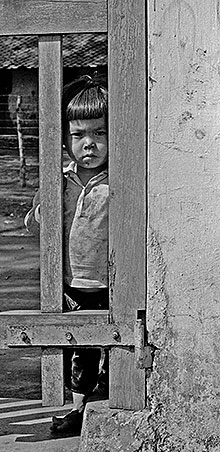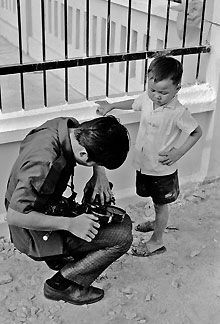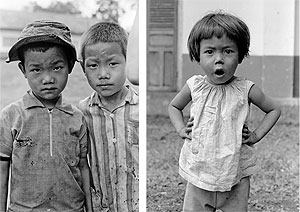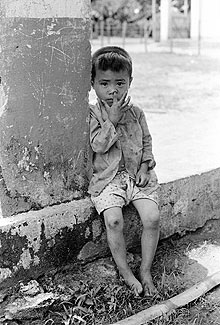 |
||||||||||||
|
November/December 2014
STORY AND PHOTOS BY KEN WILLIAMSON
That changed when I went to Vietnam in 1969 as an Army photographer. My first assignment was with the 815th Engineers in Pleiku. My primary job was to document engineer construction projects associated with building and paving Highways 14 and 19. However, I also provided photographs of newsworthy events to USECAV (U.S. Army Engineer Construction Agency Vietnam) headquarters in Long Binh. One of my first assignments was to travel with a Civic Action Team to a Catholic mission and orphanage to document the installation of an electric generator that was being donated to the church. The morning of the trip was hot and muggy with the threat of monsoon rains. The drive to the mission took about forty-five minutes. We passed Bien Ho Lake near Engineer Hill and turned off on a dirt road that took us through rice paddies and past a huge tea plantation. As we approached the mission and orphanage, I noticed a large wooden gate. Peering through its weathered boards was a young girl with an ink drawing on the back of her hand and forearm. Off to one side was a well-maintained vegetable garden tended by an elderly Vietnamese man.
The children I met and photographed that day touched me deeply. While I don’t know their names, their faces are etched into my memory. Their circumstances were heartbreaking. While I am sure they received the best care possible, I noticed their dirty and torn clothes and their solemn faces. Like many military units throughout South Vietnam, the 815th adopted the orphanage and helped provide food, clothing, and gifts. Some unconfirmed reports say that the number of orphans in Vietnam in 1969 may have exceeded 200,000. Their parents had either been killed in the war or had abandoned their children due to their families’ own poverty. The compassion shown by our troops toward the children of Vietnam was overwhelming. No wonder we found the label “baby killers” offensive. Later in my tour, when I had been reassigned to the Engineer Headquarters Public Information Detachment, I took photographs for a story about a group of dedicated engineers who volunteered their free time. Over the course of almost two years the men of the 100th Engineer Company, 159th Group, built a home for children orphaned after the 1968 Tet Offensive.
Although most of the troops who worked on the orphanage had returned to the United States, one man, Spec. 4 Dean D. Lew of Palm Springs, California, had been there at the beginning. Twice he extended his tour of duty so he could go home with the knowledge that the orphanage was completed. “I had to finish it,” he said. For their efforts, Lew and Capt. Norman D. Lamar, Jr., of Cadillac, Michigan—the commanding officer of the 100th—were awarded the Vietnamese Civic Action Medal during the colorful dedication ceremony. F In 1998 I returned to Vietnam to visit the places where I had taken photographs in 1969. One destination was the orphanage north of Pleiku. It was not easy to find, but I located it thanks to my old military map and a Montagnard guide. The church was still there, but the orphanage was gone. In its place was a school. As the children ran out to greet me, I noticed they were wearing clean, colorful clothing and had smiles on their faces. They immediately began comparing the size of their hands and feet to mine, laughing at the difference. It was good to see that the children were better off than they were in 1969. In 2005 I returned to Vietnam again. During this trip several veteran friends and I made a stop in Kontum and visited the Old Wooden Church and the Vinh Son Montagnard Orphanage. The sisters gave us light refreshments. While it was satisfying to learn that the children are in good care, it is sad to realize that there remains a great need for help because there are a reported 1.5 million orphans in Vietnam today.
|
||||||||||||
|
|
||||||||||||
|
||||||||||||
8719 Colesville Road, Suite 100, Silver Spring. MD 20910 | www.vva.org | contact us |
||||||||||||









 One of the tragedies of war is its impact on children. Loss of family, friends, and sometimes loss of limbs are some of the emotional and physical hardships that children experience in a war zone. Having grown up in a middle-class neighborhood in the United States, I had no first-hand knowledge of such tragedies.
One of the tragedies of war is its impact on children. Loss of family, friends, and sometimes loss of limbs are some of the emotional and physical hardships that children experience in a war zone. Having grown up in a middle-class neighborhood in the United States, I had no first-hand knowledge of such tragedies.  One of the nuns greeted us and invited us in for refreshments. As we walked up to the solid concrete convent, I noticed that the downspouts used to divert the water from the roof into a rain barrel had been made from soda cans. One of the nuns was cranking up a bucket of water from a nearby well.
One of the nuns greeted us and invited us in for refreshments. As we walked up to the solid concrete convent, I noticed that the downspouts used to divert the water from the roof into a rain barrel had been made from soda cans. One of the nuns was cranking up a bucket of water from a nearby well.  On November 25, 1969, a ceremony was held to dedicate the two-story concrete school and orphanage. The Venerable Thich Giai Chuong, director of the Vien-Giac Orphanage in the village of Tam Hiep, opened the ceremony with these words: “Conditions of a long and difficult war that our country has undergone for the last two decades demand in all of us, all social welfare organizations, our greater efforts and contributions.”
On November 25, 1969, a ceremony was held to dedicate the two-story concrete school and orphanage. The Venerable Thich Giai Chuong, director of the Vien-Giac Orphanage in the village of Tam Hiep, opened the ceremony with these words: “Conditions of a long and difficult war that our country has undergone for the last two decades demand in all of us, all social welfare organizations, our greater efforts and contributions.” orty-five years later the orphans of Vietnam have not been forgotten. Help for them continues today from Vietnam veterans across the United States. One such program is Friends of the Vinh Son Montagnard Orphanage. Those who served in the Central Highlands, like myself, remember the mountain people for their service and loyalty to American forces during the war. If you were in Kontum, you will remember the Old Wooden Church. The Vin Son Orphanage, adjacent to the church, is run by the Sisters of the Miraculous Medal. They provide education, a safe environment, food, clothing, and medical care. For information, go to
orty-five years later the orphans of Vietnam have not been forgotten. Help for them continues today from Vietnam veterans across the United States. One such program is Friends of the Vinh Son Montagnard Orphanage. Those who served in the Central Highlands, like myself, remember the mountain people for their service and loyalty to American forces during the war. If you were in Kontum, you will remember the Old Wooden Church. The Vin Son Orphanage, adjacent to the church, is run by the Sisters of the Miraculous Medal. They provide education, a safe environment, food, clothing, and medical care. For information, go to